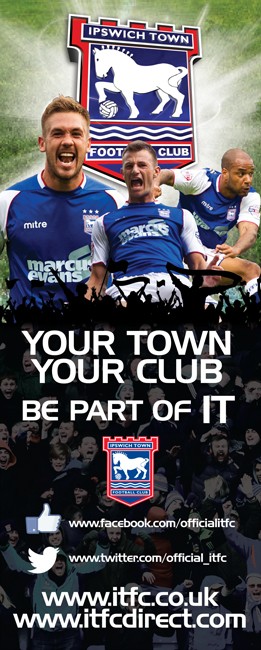No matter if you are Manchester United or a charity five-a-side team, every football club relies on the support of fans and sponsors to keep playing on. But what’s the best way to promote your local football club in business as well as on the pitch?
Freebies
Everybody loves a cheeky little freebie, so London’s Barnet FC are currently running free daily football sessions for local boys and girls aged between 12 and 18 years old – allowing them to just turn up and play. The idea is for the youngsters to have fun, and meet new friends, by training with professional football players and coaches from the club.
Solopress printed these 130gsm Gloss A5 Leaflets for Barnet FC
Every football club should be organising similar events to the Barnet FC initiative in their own communities, encouraging kids and teenagers to play and enjoy football at the grass roots level. It is a cost effective way of finding new supporters and volunteers for the club. And, you never know, a talent scout from your club might just spot the next Wayne Rooney or Andros Townsend among these keen amateur players.
Even if you are a small football club, maybe you or a friend knows a current or ex-professional footballer who might be willing to drop by and inspire local kids with a half-hour kickabout, Q&A (Question and Answer) talk or informal training session.
Football Festivals
Taking such training days and footballing workshops to the next level, why not organise a more ambitious football festival combining entertainment and education activities to rally support and publicity for your football club? The FA Girls’ Football Festival held last month in Peterborough featured everything from small sided friendly games and fun target shot sessions to football skills coaching and photo/autograph opportunities with Women’s Super League players Ellen White and Jordan Nobbs.
Solopress printed the ‘Match Day’ Information Programmes for The FA Girls’ Football Festival
Flyers and Leaflets
Of course, there is little point in organising such events unless you also go to the effort of effectively promoting them in your local community. Print up some flyers or leaflets and ask local schools, youth clubs, sports centres, gyms, stores and other appropriate venues if they wouldn’t mind displaying them at their location for you.
It is surprisingly cheap to get a leaflet or flyer professionally printed these days. For example: 5,000 A6 gloss leaflets, printed in full colour on both sides, will cost only £46 from a commercial printer like Solopress. And thanks to a quick 24-hour turnaround, you could have your flyers or leaflets ready to hand-out the day after you order them.
Posters and Banners
An eye-catching poster or banner is another great marketing tool at your disposal. The roller banner for Ipswich Town FC shown below is cleverly promoting the club’s Facebook, Twitter and websites with a persuasive “Your Town. Your Club. Be Part Of It” marketing message.
Solopress printed these Roller Banners for Ipswich Town FC
Fundraisers
The FA, the governing body of English football, recommend that football clubs organise at least two major fundraising events per year, along with weekly raffles or lottery style draws.
Experiment with the prizes on offer for any giveaways at your football club to see which one’s generate the most interest from your participants. Surprisingly enough, it may not necessarily be the most expensive gifts that people want to win.
It’s vital that at least one person at your club takes full responsibility for such fundraising. As the fundraiser is probably going to be blagging the raffle and competition prizes for free, or heavily discounted prices, from club fans and local business owners alike, he or she should ideally be a person with persuasive charm and the gift-of-the-gab.
PR
Don’t forget that generating lots of coverage about your football club in the local press is still of the utmost importance to the success or failure of your marketing campaign, even in this digital age. Introduce yourself to local sports and news writers and get to know them. Look for the ‘Contact Us’ section on the newspaper’s website to find their e-mail and telephone contact details. Alternatively, the writer may mention their e-mail address or personal Twitter page in the articles they write for the paper.
These busy journalists are always looking out for a good, original story to fill the pages of their newspaper – especially if these stories are accompanied by an interesting photo. If the players on your football team have won a trophy, helped the local community or raised funds for a worthy cause or charity, e-mail the journalists a press release about this particular triumph, and then follow this up with a brief but friendly phone call to see if they need anything else from you to write up a story. Just remember to supply all the images in the highest quality possible. That means sending photographs with a resolution that’s at least 300dpi or higher.
As this IS a digital age, don’t just target traditional newspaper journalists with publicity materials. Use the web search capabilities of Google and Bing to find any local sports or community bloggers in your area – and then add them to your PR mailing list.
Football Club Newsletters
Keeping fans and sponsors informed on the latest news at your football club is another marketing must – whether that’s using print or e-mail to deliver it. If you manage to attract enough subscribers, a popular newsletter will also give you the opportunity to generate more income for your club by selling advertising space in it.
Social Media
Likewise, utilise the power of social media networks like Twitter, Facebook, YouTube and Instagram to help spread the word about your football club. Urban street football and inspirational soccer tricks, for instance, are fantastic subjects for YouTube and Twitter’s short Vine videos. Another excellent tip is to join or create a community for your local football club on Google+.
Make sure you tag all of your social media posts with the correct keywords, like “football” or “[your location]”, so that people can easily find you when they are searching online for football or community events being held in their local area.
Although the majority of social media is totally free to use, it still takes a lot of time to keep this marketing outlet regularly updated with fresh and interesting new content like news, photos and videos. Don’t even think about setting up any social media account for your football club unless you are actually prepared to put all the time required into this project – in an on-going basis. Nothing says you simply don’t care about your footie fans more than a Facebook or Twitter page that hasn’t been updated in months or years.









Great post, thanks for info!
I think it’s a fab idea about the free daily football sessions. It’s a great way to showcase the sport and harvest future talent. It also encourages kids to socialise, stay active and learn something new.
Comments are closed.